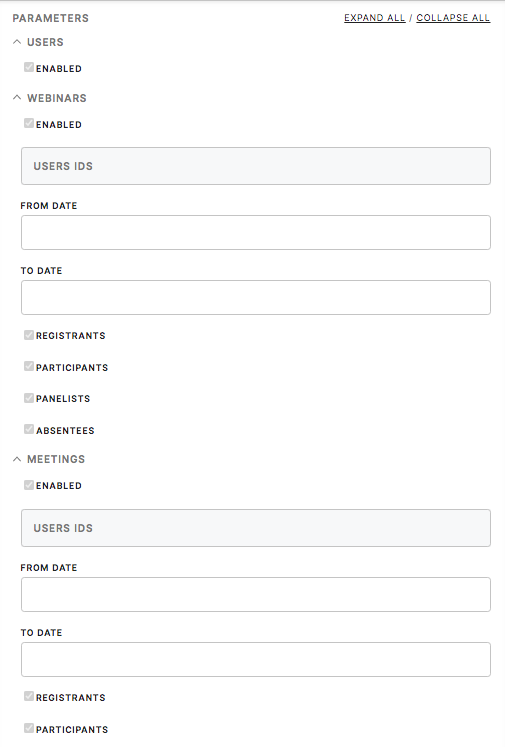Connector Zoom
Zoom is a widely-used video conferencing platform that facilitates online meetings, webinars, and virtual collaborations. A Zoom connector enablesis a bridge to loadexport ofdata from Zoom to the dataCDP. This connector allows users to seamlessly load information related to users, meetings, and webinars directly from the Zoom platform into the CDP, which can help to centralize and organize data pertaining to their virtual interactions, making it easily accessible for youanalysis users,and meeting,integration aswith wellother ascustomer-related webinars. data.
Requirements
The prerequisite is to set up authorization tofor the Zoom account onefrom wisheswhich you wish to withdraw datadata. from. ThereforeTherefore, it is important to hold credentials for this step.
Data In/Data Out
| Data In | N/A |
| Data Out |
All the data is saved in CSV format |
Learn more: about folder structure in configurations, please go to this article.
Parameters
Users
|
Enabled |
Mark enabled if you wish to load data about users Users data will be loaded in JSON format under |
Webinars
|
Enabled |
Mark enabled if you wish to load data about users Users data will be loaded in JSON format under
|
|
User IDs |
It is possible to specify further which User Ids to load. It is an optional field. If left empty it will fetch all user Ids. |
|
From/ To Date |
It is possible to specify the timeframe of the loaded data. It is an optional field. If left empty from to component will execute all data (including planned). This can be useful as you may have planned events and you wish to see them in the reporting even though they did not happen yet. To set correct incremental loading To |
|
Registrants |
Mark Registrants to withdraw data about your registered audience. Data will be loaded in JSON format under
|
|
Participants |
Mark Participants to withdraw data about your participants' audience. Data will be loaded in JSON format under
|
|
Panelists |
Mark Panelists to withdraw data about your panelists' audience. Data will be loaded in JSON format under
|
|
Absentees |
Mark Absentees to withdraw data about your absentees' audience. Data will be loaded in JSON format under
|
Meetings
|
Enabled |
Mark enabled if you wish to load data about users Users data will be loaded in JSON format under
|
|
User IDs |
It is possible to specify further which User Ids to load. It is an optional field. |
|
From/ To Date |
It is possible to specify the timeframe of the loaded data. It is an optional field. If left empty from to component will execute all data (including planned). This can be useful as you may have planned events and you wish to see them in the reporting even though they did not happen yet. To set correct incremental loading To |
|
Registrants |
Mark Registrants to withdraw data about your registered audience. Data will be loaded in JSON format under
|
| Participants |
Mark Participants to withdraw data about your participants' audience. Data will be loaded in JSON format under
|

